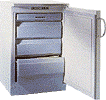 |
Ice Cream |  |
|
Shirley O. Corriher, a food scientist, is a contributing editor to Fine Cooking and the author of the award-winning CookWise (William Morrow). From FC #40, pp. 78-79. Getting the Best Texture in Ice Cream One of the joys of making ice cream at home is having the freedom to change ingredients and personalize a recipe to suit my mood. But no matter what my flavor of the week is, I always aim for ice cream with a creamy, smooth texture, a soft consistency, and a full body that's neither too airy nor too dense. To get this wonderful mouth-feel, it helps to know how different ingredients and techniques affect texture and consistency. Dairy products improve smoothness. When an ice-cream mixture gets poured into a machine and stirred, some of the liquid freezes into pure ice crystals while some of it remains liquid. The goal is to keep these developing ice crystals small and plentiful, so you end up with a smooth, creamy texture. If they grow too large, the resulting ice cream is coarse and icy. Cream and milk promote smoothness and lightness. The high fat content in heavy cream and whipping cream coats ice crystals, preventing them from enlarging. It also acts as a lubricant between crystals, making even ice cream with larger crystals feel smooth on the tongue. Cream is also excellent at trapping and holding air when the mixture is stirred and frozen, which gives the ice cream more body. As important as cream is to great ice cream, however, it's possible to overdo it. If you've ever had ice cream that seemed to coat your mouth with fat, it probably had too much cream. The solution is to reduce the cream and add a lower-fat dairy product, such as half-and-half or milk.
Milk lightens ice cream because of its proteins, which are superior to fat at trapping air (though not as good at holding it). This, by the way, is why skim milk foams up better than whole milk for cappuccino. Milk also contributes to smoothness, thanks to its high concentration of milk solids (such as calcium salts and lactose), which are even more effective than fat at controlling crystal size. Use condensed, evaporated, or powdered dry milk in moderate amounts. Like milk, these ingredients have lots of milk solids, so ice crystals stay small. But they're also brimming with lactose (milk sugar), which makes them useful in another way. Lactose, like any sugar, lowers the freezing point of ice-cream mixtures. That means more of the mixture stays liquid at freezer temperature and the ice cream will be softer. But beware, if there's too much of these products, lactose crystals will form and you'll end up with a sandy-textured ice cream. You'll notice that Jim Peyton's ice creams on pp. 5455 contain some evaporated milk (as well as cream and milk)--enough to make the ice creams very smooth and soft, but not enough to make them gritty. Adding fruit preserves is a great idea. They have concentrated flavor plus a small amount of pectin, which keeps ice crystals small and improves creaminess. Preserves can be swapped out tablespoon for tablespoon with sugar. Egg yolks, those great emulsifiers, will also contribute silky smoothness. For flavor, I always add a small amount of salt (about 1/8 teaspoon). It enhances both the perception of sweetness and the flavor of the ice cream. Sugar and alcohol make ice cream softer. Sugar makes ice cream softer because it lowers the freezing point of a liquid. For an ice cream that can be scooped right out of the freezer, you need just the right amount of sugar--too little and the ice cream is as hard as a brick, too much and you have mush. If you find that your favorite ice cream recipe is brick-hard and nearly impossible to scoop, try adding more sugar next time. Or try replacing some of the sugar with honey. Because honey consists of sugars with smaller molecules than those of table sugar, it's more than twice as effective at lowering the freezing point as table sugar. Harold McGee, a food scientist, recommends substituting 1 tablespoon of honey for 2 1/2 tablespoons of sugar in ice cream. Adding a liqueur or wine to an ice-cream mixture will make it softer because alcohol, like sugar, lowers the freezing point of a liquid. If you like the firmness of a particular recipe but want to add a liqueur for flavor, you might counter the addition of alcohol by cutting back on the sugar. Liqueur is preferable to wine because, at freezer temperature, a wine's flavor would be muted. Techniques that affect texture: If you're using milk or half-and-half in the recipe, you should heat it to 175°F, just below scalding. I don't know exactly what changes this heating causes--perhaps it denatures or partially coagulates some of the proteins--but whatever is occurring, the effect is a noticeably smoother ice cream. It isn't necessary to heat heavy cream or whipping cream, neither of which has very much protein. Chilling before freezing improves body, texture, and flavor. I recommend "aging" the mixture for 4 to 12 hours at refrigerator temperature for the best texture. |
|
Selecting an ice cream When choosing an ice cream, the heavier the container the less overrun the ice cream contains. Overrun is a term to describe the amount of air an ice cream contains; ice cream needs a bit of air to keep it soft and spoonable! An ice cream with 20 to 50 percent overrun (10 to 25% air) will be denser, creamier and probably a lot more satisfying than one with 100% overrun. If you want to indulge a bit more often than occasionally, try some of the varieties of sugar free and fat free ice cream available now. Ice milk and reduced fat ice cream are also good alternatives; these contain sugar, but are lower in fat than regular ice cream. Or consider making your own ice cream. Electric ice cream makers are easy to operate and allow for complete control over the amount of sugar and fats in the ice cream. You could even make fruit sorbets with absolutely ZERO fat! Making your own ice cream is not only fun but can give you better control of the calories and the freedom to create your own favorite flavors. No matter what your choice, be sure to include it into your allotted carbohydrates and fats for the day. Serving Size One half (1/2) cup of regular ice cream without the addition of chocolate, nuts or any other added candy-like ingredient is considered one serving. Stick to this recommended serving size when managing your diet. Your best bet when sticking to a diet and indulging in ice cream is to select a vanilla ice cream and augment it with an array of your favorite additions. Stirring in your own additions allows you to control the amount of add-ins without worrying about added fat and calories that may be found in the pre-made specialty ice creams. Stir in a small amount of your favorite nuts, a small spoonful of peanut butter or top the ice cream with fresh summer fruits. When making ice cream, add 1/4 to 1/2 C white corn syrup (Golden Syrup would do) to avoid ice crystals and keep the ice cream creamy. If the ice cream is very soft, the brine is not cold enough. More salt should be added to reduce the brine temperature. If the ice cream is coarse and ice in less than 20 minutes, the brine has become to too cold too quickly. Too much salt has been used. Make the ice cream mix the day before it is frozen to get a smoother product and a higher yield. Electric freezing takes longer than hand operated. Use crushed ice for freezing. Freeze at least 3 hours before the ice cream is to be served. Be sure dasher is properly centered in the freezer can. Add liquid flavours before freezing but if you want to add fruits or nuts, add them after freezing and before hardening. Use a wire whip to blend ingredients for best results. Clean the salt off all the metal parts of the freezer to prevent corrosion. Place the ice cream churn container in the freezer at least overnight or longer to get it ice cold. This will make the churning go quicker. |
! Disclaimer !
Return to Cooking Hints Index Page